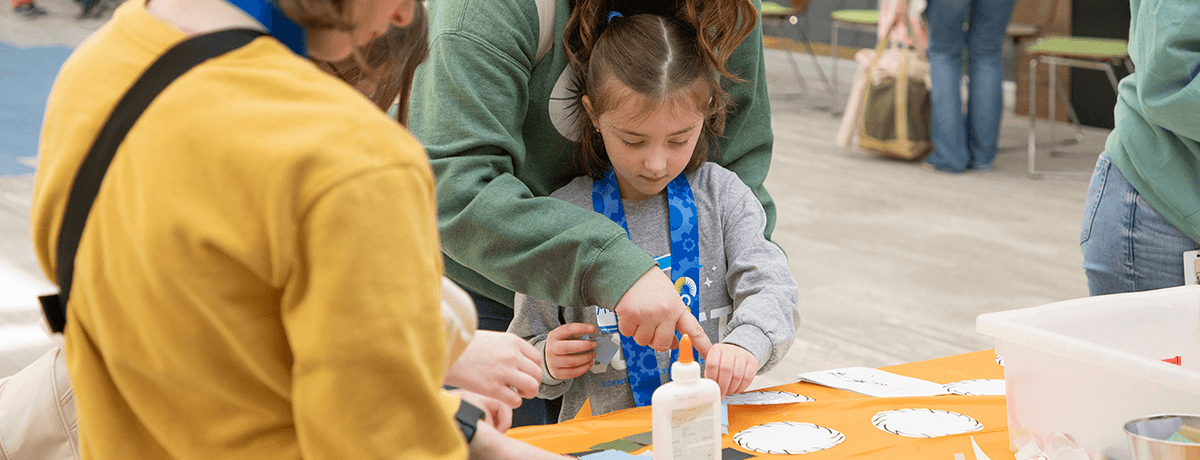2025-2026 School Year Enrollment Now Open. Click Here
2025-2026 School Year Enrollment Now Open. Click Here

Art is a beautiful way for your child to express themselves and learn how to interact with others and the world around them. Creative time can impact your child’s emotional, social, and cognitive development. The projects you complete with your child can leave a lasting impact on them and strengthen your family dynamic. Keep reading to discover the benefits of this art form and find your new favorite collaborative projects.
Collaborative art is any form of art that involves team members working together. For these projects, each team member significantly contributes to the product, and the result is unique and complex work that everyone can feel proud to share.
This form of art can strengthen communities and build relationships. Like any art, collaborative art can come in many forms. For children, sensory play can be a form of collaborative art where children interact with new ideas and learn to play with others. There is no limit to what is or isn’t collaborative art as long as more than one person contributes significantly to the finished product.
Collaborative family art projects benefit children and families. Alongside impacting their development, these projects can create memories your child will cherish. Benefits of family art projects include:
Finding time in busy schedules can be challenging, but it’s well worth the reward of spending time with your child and encouraging them to refine their skills and expand their abilities. Finding time for art projects benefits your child. Here are some of the best ways to make time for your family projects:
Now that you know the benefits of family arts and crafts and how to make time for these collaborative projects, you need some fun ideas to do at home. Here are some excellent collaborative projects you can complete with your family.
Murals are a great family project that can take as little or as much time as you’d like. Create a mural with one large canvas and a stencil drawing or freehand outline. You can also craft a paint-by-number using small paper or canvases over a large piece of cardboard or plywood. To complete this project, have each family member paint a small section around the table together.
Lego tables empower your family to create new projects over and over again. A used coffee table, glue, storage containers, a stool, and Lego base plates are all you need. Prime and paint the table whatever colors your child loves. Once dry, glue the base plates and fill storage containers with Lego bricks. Your family can visit the table anytime you want to create a new project or add to an old one.
Grab some rocks and paint for this fun project. Any time you want to get creative, pull out your supplies and paint the night away. Keep your collection at home or place them in locations throughout your town to surprise neighbors and friends.
With wood, string, and pushpins, you can create intricate designs to display in your home. You can use stencils to outline the picture or let your child work freely. Either way, you can complete new designs every day and rework existing pieces as often as you want.
You can create a cornhole board by using plywood. You can ask your child to help with the construction, but your collaborative project will primarily be painting the boards. Paint a base color to hide the wood, and work with your child to paint unique designs to customize the set. Every time you play cornhole, you’ll remember the fun you had painting the boards together.
Building a bookshelf is fun and practical whether your child is a book lover or has a stock of toys with nowhere to go. Gather wooden boards and construct a shelf your family can enjoy. Ask them to paint it with you and decorate it when you finish it. Set the bookshelf up in their bedroom or place it in the living room, where they can see it daily.
Building a treehouse takes time and dedication. You’ll need tools to cut the boards and adjust the construction. You’ll also need to measure the tree you’re using and find stable hardware to keep the treehouse in a safe condition. Your child can help you measure, cut, and place the pieces. They can also paint the boards and pick out unique features like curtains or welcome mats. Every time they enter the treehouse to enjoy the beautiful space, they’ll think of you.
CCA understands the importance of family in education, so we encourage our teachers and parents to work together to create enriching student experiences. At CCA, your child will find unique opportunities and foster a love of learning in a dynamic environment.
We use personalized learning to align curricula with each child’s interests and goals. This strategy empowers us to serve each student and family in a way that works for them. Contact our team to learn more about what we can do for your family.
2025-2026 School Year Enrollment Now Open. Click Here